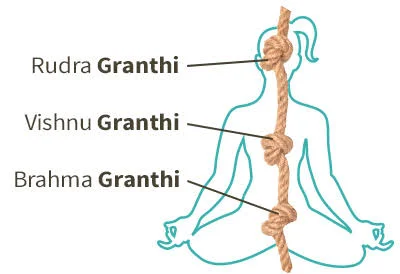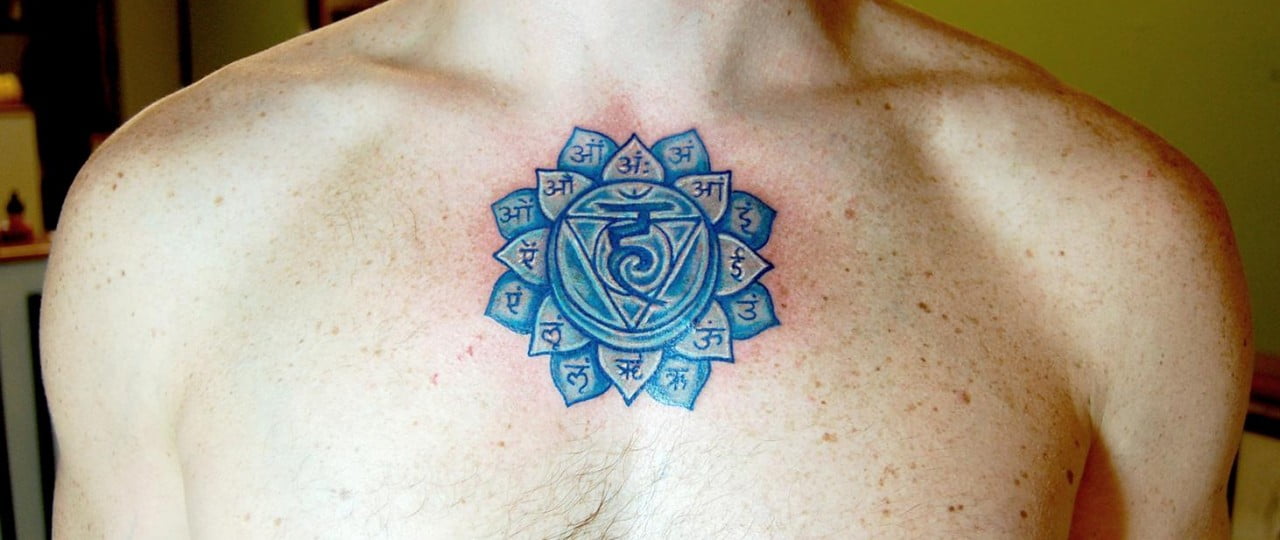In the yogic tradition, particularly within Kundalini Yoga and Tantra, practitioners encounter profound internal obstacles known as the Three Granthis in Yoga or knots. These knots, Brahma Granthi, Vishnu Granthi, and Rudra Granthi, are psycho-energetic blockages that prevent the free flow of prana (life force) and kundalini energy through the central channel, known as the Sushumna Nadi. They correspond to deep attachments to the physical, emotional, and intellectual realms. So, see below the Three Granthis in Yoga.
Table of Contents
The Three Granthis in Yoga:
Understanding and transcending these granthis is essential for those on the path of spiritual awakening and self-realization.
1. Brahma Granthi (The Knot of Brahma):
Location:
Located at the Muladhara Chakra (Root Chakra), near the base of the spine.
Association:
This knot is linked with the physical body, material attachments, and survival instincts.
Symbolism:
- Tied to gross matter, bodily identification, sensual pleasures, fear, and attachment to worldly existence.
- Represents the illusion that we are only the body.
Challenges:
- Over-identification with the body.
- Fear of insecurity, lack, or death.
- Greed, attachment, and an excessive desire for comfort or safety.
How to Untie Brahma Granthi:
- Asanas: Grounding postures (e.g., Tadasana, Vrikshasana, Malasana).
- Pranayama: Bhastrika, Kapalabhati to energize and awaken the lower chakras.
- Mantra: Chanting Lam, the bija mantra of the root chakra.
- Kriyas: Practices focusing on Muladhara Chakra and Kundalini awakening.
- Awareness: Cultivating detachment from material possessions and bodily identity.
Vishnu Granthi (The Knot of Vishnu):
Location:
Situated at the Anahata Chakra (Heart Chakra), in the middle of the chest.
Association:
This knot is related to the emotional body, attachments, ego identity, and relationships.
Symbolism:
- Governs our emotional connections and the ego’s desire for identity, validation, and love.
- It ties the aspirant to emotions, pride, and attachments to roles (e.g., as a parent, lover, friend).
Challenges:
- Emotional turbulence.
- Fear of rejection or abandonment.
- Needing external approval or affection.
- Clinging to relationships or past wounds.
How to Untie Vishnu Granthi:
- Asanas: Heart-opening poses like Bhujangasana, Ustrasana, Matsyasana.
- Pranayama: Nadi Shodhana, Anulom Vilom to balance energies.
- Mantra: Chanting Yam, the bija mantra of the heart chakra.
- Bhakti Yoga: Devotional practices to develop unconditional love and surrender.
- Self-Inquiry: Understanding and dissolving emotional attachments and ego-based identity.
3. Rudra Granthi (The Knot of Rudra)
Location:
Located at the Ajna Chakra (Third Eye Chakra), between the eyebrows.
Association:
Related to the intellect, spiritual ego, and attachment to siddhis (psychic powers) or spiritual pride.
Symbolism:
- This is the most subtle knot, associated with the mind’s identification with thoughts, knowledge, and self-image.
- Represents the illusion of duality and the fear of merging into the formless.
Challenges:
- Attachment to intellectual understanding.
- Pride in spiritual accomplishments.
- Resistance to letting go of the “self” in its highest sense.
How to Untie Rudra Granthi:
- Meditation: Silent awareness, trataka, or Ajna Chakra concentration.
- Mantra: Chanting Om, the universal sound and bija mantra of Ajna Chakra.
- Jnana Yoga: Inquiry into the nature of the Self (“Who am I?”).
- Surrender: Letting go of control, surrendering to the Divine Will.
- Samadhi Practices: Deep states of meditation to transcend duality.
Granthis and Kundalini Awakening:
When kundalini energy rises through the spine, it encounters these three knots. Unless they are untied through spiritual discipline, purification, and inner work, kundalini cannot pass freely upward. Each granthi must be overcome in sequence:
- Brahma Granthi must be pierced for the energy to rise from Muladhara to Manipura.
- Vishnu Granthi must be overcome to rise from Manipura to Vishuddha.
- Rudra Granthi must be transcended to enter the realm of Ajna and finally Sahasrara, the thousand-petaled lotus at the crown.
Symbolic Interpretation of the Granthis:
| Granthi | Chakra Zone | Associated Energy | Obstacle | Transcendence Brings |
|---|---|---|---|---|
| Brahma | Muladhara | Earth, survival | Attachment to body & matter | Strength, grounding, and awakening of energy |
| Vishnu | Anahata | Emotions, love | Ego-identity, emotional bondage | Compassion, devotion, balance |
| Rudra | Ajna | Mind, intuition | Spiritual ego, mental constructs | Unity consciousness, insight, and Self-realization |
Conclusion:
The Three Granthis are not merely theoretical constructs, but experiential blocks encountered on the path to higher consciousness. Their untying signifies not just the rise of kundalini but the evolution of the self from a limited, ego-bound being to a liberated soul rooted in truth and unity.
The journey through these knots is a gradual process of purification, inner work, and surrender. With disciplined sadhana, sincere aspiration, and the grace of the Divine, one can move through these energetic thresholds and awaken to the infinite potential within.
FAQ:
1. What are the Three Granthis in Yoga?
The Three Granthis—Brahma Granthi, Vishnu Granthi, and Rudra Granthi—are energetic knots or psychic blockages located along the Sushumna Nadi, the central channel of energy in the body. They symbolize psychological and energetic obstacles that hinder spiritual progress and the upward movement of Kundalini energy.
Q. Why is it important to untie the Granthis?
A. Untying these granthis allows Kundalini energy to rise unimpeded through the chakras, leading to higher consciousness, deep inner transformation, and ultimately, self-realization.
Q. How do you know if a Granthi is active or stopping your progress?
A. You may experience:
- Repeated patterns of fear, desire, or pride.
- Emotional turbulence or spiritual stagnation.
- A feeling of being “stuck” in your practice.
- Difficulty in progressing beyond a certain chakra or inner realization.
Q. Can the Granthis be untied through physical yoga alone?
A. While asana and pranayama are essential, untying granthis often requires:
- Meditation
- Self-inquiry
- Devotion (Bhakti Yoga)
- Intellectual surrender (Jnana Yoga)
- Inner purification (Yamas and Niyamas)
Q. Is it dangerous to awaken kundalini before untying the granthis?
A. Yes, premature or forceful kundalini awakening without proper preparation may result in:
- Psychological imbalance
- Energetic disturbances
- Emotional upheaval
That’s why gradual, disciplined spiritual practice under the guidance of a knowledgeable teacher is advised.
Q. Are the Granthis mentioned in ancient texts?
A. Yes. The granthis are mentioned in classical texts like:
- Hatha Yoga Pradipika
- Shiva Samhita
- Gheranda Samhita
They are also referenced symbolically in Tantra and Upanishadic literature.
Q. Can one untie all the granthis in a single lifetime?
A. Yes, but it requires intense sadhana, sincere self-effort, and often, the grace of the Guru or Divine. Many practitioners work through the granthis over several years or lifetimes.
Q. What happens when all three Granthis are untied?
A. When all granthis are untied:
- Kundalini flows unobstructed to the Sahasrara Chakra.
- The yogi enters Samadhi or superconscious states.
- There is a profound realization of the Self and liberation (Moksha).





